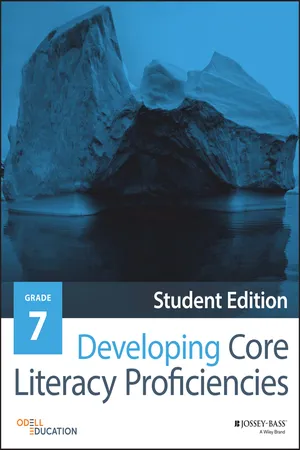
- English
- ePUB (mobile friendly)
- Available on iOS & Android
About This Book
The Developing Core Literacy Proficiencies program is an integrated set of English Language Arts/Literacy units spanning grades 6-12 that provide student-centered instruction on a set of literacy proficiencies at the heart of the Common Core State Standards (CCSS).
- Reading Closely for Textual Details
- Making Evidence-Based Claims
- Making Evidence-Based Claims about Literary Technique (Grades 9-12)
- Researching to Deepen Understanding
- Building Evidence-Based Arguments
The program approaches literacy through the development of knowledge, literacy skills, and academic habits. Throughout the activities, students develop their literacy along these three paths in an integrated, engaging, and empowering way.
Knowledge: The texts and topics students encounter in the program have been carefully selected to expose them to rich and varied ideas and perspectives of cultural significance. These texts not only equip students with key ideas for participating knowledgeably in the important discussions of our time, but also contain the complexity of expression necessary for developing college- and career-ready literacy skills.
Literacy Skills: The program articulates and targets instruction and assessment on twenty CCSS-aligned literacy skills ranging from "making inferences" to "reflecting critically." Students focus on this set of twenty skills throughout the year and program, continually applying them in new and more sophisticated ways.
Academic Habits: The program articulates twelve academic habits for students to develop, apply, and extend as they progress through the sequence of instruction. Instructional notes allow teachers to introduce and discuss academic habits such as "preparing" and "completing tasks" that are essential to students' success in the classroom.
The program materials include a comprehensive set of instructional sequences, teacher notes, handouts, assessments, rubrics, and graphic organizers designed to support students with a diversity of educational experiences and needs. The integrated assessment system, centered around the literacy skills and academic habits, allows for the coherent evaluation of student literacy development over the course of the year and vertically across all grade levels.
Frequently asked questions
Information
UNIT 1
READING CLOSELY
FOR TEXTUAL DETAILS
DEVELOPING CORE LITERACY
PROFICIENCIES
GRADE 7
“We reckoned now that we were at the Pole”

GOAL
- Examine things closely (images, videos, websites, and texts).
- Ask and use questions to guide your close examination.
- Find the key details—clues—that tell you something.
- Make connections among those details.
- Use those connections to develop an observation or conclusion.
TOPIC
ACTIVITIES
READING CLOSELY FOR TEXTUAL DETAILS LITERACY TOOLBOX
HANDOUTS
Reading Closely Graphic
Guiding Questions Handout
Attending to Details Handout
Table of contents
- Cover
- Title Page
- Copyright
- Table of Contents
- Acknowledgments
- Introduction to the Core Literacy Proficiencies: Becoming a Literate Person
- Unit 1: Reading Closely for Textual Details: “We reckoned now that we were at the Pole”
- Unit 2: Making Evidence-Based Claims: “We organized!”
- Unit 3: Researching to Deepen Understanding: Water: Why is it so valuable?
- Unit 4: Building Evidence-Based Arguments: “Doping can be that last 2 percent“
- End User License Agreement